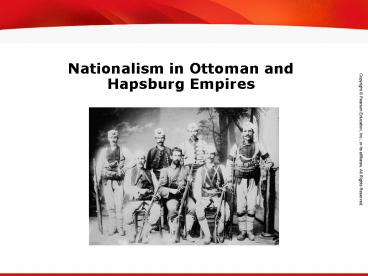Nationalism in Ottoman and Hapsburg Empires - PowerPoint PPT Presentation
1 / 15
Title:
Nationalism in Ottoman and Hapsburg Empires
Description:
Nationalism in Ottoman and Hapsburg Empires Describe how nationalism contributed to the decline of the Hapsburg empire. List the main characteristics of the Dual ... – PowerPoint PPT presentation
Number of Views:111
Avg rating:3.0/5.0
Title: Nationalism in Ottoman and Hapsburg Empires
1
Nationalism in Ottoman and Hapsburg Empires
2
Objectives
- Describe how nationalism contributed to the
decline of the Hapsburg empire. - List the main characteristics of the Dual
Monarchy. - Understand how the growth of nationalism
affected the Ottoman empire.
3
Terms and People
- Francis Joseph Hapsburg emperor of the Dual
Monarchy of Austria-Hungary - Ferenc Deák a moderate Hungarian leader who
helped work out the compromise that created the
Dual Monarchy of Austria-Hungary - Dual Monarchy an agreement that made Austria
and Hungary different states with their own
constitutions and parliaments, but with shared
ministries of finance, defense, and foreign
affairs
4
How did the desire for national independence
among ethnic groups weaken and ultimately destroy
the Austrian and Ottoman empires?
The Austrian Hapsburgs and Ottoman Turks ruled
empires with diverse ethnic groups. As
nationalist feelings grew among these groups, the
power of the empires declined.
5
Europe was a patchwork of different
nationalities between 1800 and 1914. Nationalists
pushed for self-rule, which brought about the
decline of the Austrian and Ottoman empires.
6
During the early 1800s, the Hapsburg rulers of
Austria tried to prevent change and ignored
liberal demands.
They even tried to prevent industrialization,
fearing that it would change the empires
traditional way of life.
7
(No Transcript)
8
The Hungarians wanted the right to rule
themselves.
- The new emperor made some reforms including the
formation of a legislature. - This did not satisfy the Hungarians, however,
because the body was led by German-speaking
Austrians.
During the 1848 uprising, 18-year-old Francis
Joseph inherited the Hapsburg throne. He would
rule until 1916.
9
A moderate Hungarian leader named Ferenc Deák
helped to work out a solution. The Dual Monarchy
of Austria-Hungary was formed in 1867.
After Austrias defeat in its war with Prussia,
Hungarians pressured the Hapsburgs for a
compromise.
10
The Dual Monarchy of Austria-Hungary
11
Hungarians were happy, but others were not.
Slavic people still lacked a voice in
government. Nationalist leaders called on them to
unite.
Despite the compromise, nationalist unrest
continued to increase in the empire.
Unrest among nationalists paralyzed governments
in the early 1900s.
12
- The Ottomans ruled a multinational empire that
stretched from Eastern Europe to North Africa and
the Middle East. - Many revolts broke out against the Ottomans in
the 1800s as nationalist groups sought self-rule.
The Ottoman empire faced the same problem as the
Austrian empire.
13
Some states gained independence from the
Ottomans by 1878.
14
The Ottoman empire faced challenges from other
European powers in the mid-1800s.
- Russia pushed south toward Istanbul and the Black
Sea. - Austria-Hungary took control of Bosnia and
Herzegovina. - Britain and France eyed Ottoman lands in the
Middle East and North Africa.
European powers viewed the Ottoman empire as the
sick man of Europe.
15
Rivalries contributed to conflicts in the
Balkans.
- Russia fought several wars against the Ottomans.
Other powers also took sides. - Subject people revolted and then fought among
themselves. - This Balkan powder keg would explode into World
War I.
Ottoman soldiers in the Balkans































